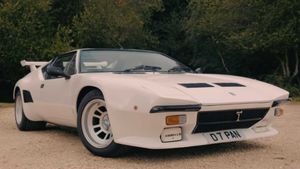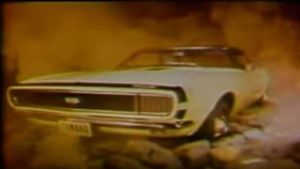Traditionally lampooned and ignored by collectors, the 800 has now found an audience with a new breed of classic car enthusiast. Here's why
Approaching any Rover 800 Sterling with an open mind is difficult. That badge on the front, with its accompanying chrome grille and British stature, largely remains a joke – to the uneducated proletariat, at least. The shape remains one of failure, of submission to foreigners and of outright embarrassment when trying to
The car reflects an empire reclaimed by powers once far removed from the ingenuity and bravery Britannia offered the automotive world. There is prestige, there is horsepower, there is refinement; yet it’s drowned out by the Viking emblem and its associated stigma. Approach almost any car collector to talk Rover 800s, and you’ll be laughed out of the garage.
That’s a shame, as Rover’s saloon from the era of Britpop and Brosnan’s Bond is not the automotive disaster our brainwashed masses believe it to be. Yes, certain aspects of criticism are well founded: build quality and image are all appalling, with rotten interior plastics and body panels that offer less structural rigidity than Theresa May’s Cabinet. Ironic, seeing as Government ministers were once regularly chauffeured about their business in the 800.
However, there remains a vast swathe of positives to justify having this 1960s-standard ‘car for the millennium’ on your drive. Despite a sense of eerie desperation, the styling remains surprisingly pleasant on the eye; Gordon Sked’s lines ageing with grace, rather than clinging to former glories in the way of some contemporaries. The related Honda Legend appears somewhat distasteful in comparison, while the Alfa Romeo 166 has aged faster than Bernard Manning’s stand-up routine. Meanwhile, the Germans may be sensible, but their aesthetics are hardly riveting.
Entering the 800’s cabin, you leave the pressures of the day far behind thanks to seats that offer unparalleled comfort in this class. The air of vagabond nobility is intoxicating, with lashings of wood and leather adding to the homely graces. While Jaguars can take mantelpiece dashboards and orgies of old-school materials too far, the Rover still feels like a car. Deep carpets and quilted door cards, along with padded armrests and clear-cut instruments, bestow the interior with an incredibly upmarket feel that dissipates only as you discover the imperfections.
The handbrake construction appears cheap, with the gaiter made from what feels like the flimsy separator between layers of Cadbury Milk Tray. The cut edges of the dashboard binnacle are hardly refined, and other aspects of trim are wholly questionable. While the plastic inserts feel rough and loose, the electric window and seat controls seem second rate to the touch. This is odd, as despite sharing the same switchgear and trim, the Range Rover P38a of the period never felt tacky.
Yet you can forgive these quality deficiencies once on the move, as the ridged bonnet slices through the scenery. Handling may be wayward, and tight manoeuvres at speed purely for the brave, but the Rover 800 is entertaining should you feel enthusiastic; sedate, comfortable and safe if you don’t.
When the car was employed by the UK’s police forces, disgruntled officers dubbed the humble bobby’s 800 the ‘General Belgrano’ – comparing its body roll with that of the Argentinean battleship, not to mention that doomed, sinking feeling when attempting quick-fire direction changes or stopping exercises.
Of course, the 800’s other major issue was public image. Rover was still batting off the stench of British Leyland failure, and the brand’s customer base did it no favours. If it wasn’t patriotic, if misguided, retirees splashing out on a new model with their first pension cheque, then seeing the likes of Tony Blair gracing showroom-fresh examples could hardly be termed as kudos. Rover’s case was not helped by the association with age-old gentleman kangarooing out of junctions accompanied by the whiff of burning clutch, or societal creepers destined to a career of backstabbing and egotistical one-upmanship.
Successful businessmen lounged in their BMWs and Mercedes, whereas sensible drivers preferred the Japanese imports flooding the market. Despair and loyalty appeared to be all that drove willing customers into the arms of Rover. Indeed, as sales figures would have you believe, the main reason the 800 kept its head above water in the home market was that it was made in Britain.
Nevertheless, with the arrival of the Rover 75, it was all over. Dealerships couldn’t give away the 800, and even ridiculous finance deals saw sales brochures left unclaimed. As depreciation values spiralled downwards, the model was lost on the secondhand market.
Yet in many regards, today the Rover mixes in with its German and Japanese rivals. Its burgeoning classic status sees the absolution of quality irritations and drivetrain niggles, as fans understand that while any well heeled 800 may not be great in one particular area, it is instead rather good in all of them.
This comfortable old barge – this slice of Longbridge mentality – laps up any long journey with ease. There’s minimal road noise and the exhaust emits a healthy burble, while the clichéd ‘sense of occasion’ means every slow bend and roundabout is a grin-inducing experience. In period, this ‘budget Bentley’ brought an air of pride to those for whom membership of the local golf club was an aspiration, bestowing opulent comfort on those who wouldn’t otherwise have the chance.
However, the car’s cash-strapped development is quite apparent when you start to push hard. The transmission is often indecisive, changing up and down with the doggedness of a wrecking ball. It doesn’t so much feel like a gearbox as someone careering into the rear of the car.
Planting the accelerator into the shagpile results in stunted acceleration, as the auto seemingly passes a decision via a selection committee before gingerly and clumsily punching down. This can turn any normal overtaking manoeuvre into a heart-stopping moment of terror. Yet for cruising around town and murmuring along quiet roads, the drive is largely faultless.
When traversing the country, only the ride quality lets down the 800. While comfort levels are rarely affected, the lurch over undulating surfaces soon becomes tiresome. The model’s development history makes it clear that the suspension and stance were designed for the American market. Sadly, the first-generation 800 made so little impact Stateside that Rover pulled out before the launch of the 800 Coupé – leaving the Europeans with questionable posture when the going got rough.
Hitting a pothole anywhere above crawling speed results in a wallowing yet firm ride, leaving the driver to process steering-wheel vibration through their elbow joints. Negotiating a farm lane will undoubtedly shake the more delicate parts of the dashboard onto the floor.
These grievances aside, there is very little to condemn Rover’s Dynasty-era flagship. While it might initially have seemed cheap, as a replacement for the preceding SD1 the 800 hit the spot perfectly. If the SD1 Vitesse was ‘the poor man’s Aston Martin’ (Motor magazine), then the 800 Sterling can only be described as ‘the working man’s Jaguar’. It’s sensible enough for daily use, with a dollop of excitement when working up through the rev range, teamed with a sizeable boot and ample headroom even for six-footers. As a classic commuter with cost-effective insurance, nothing comes close today.
If you’re searching for something harder hitting within the 800-series range, hunt down a V6 variant. While the 2.0-litre eight- and 16-valve engines aren’t especially powerful, and the diesel and turbo units leave refinement largely to be desired, the Honda-derived 2.5 and 2.7-litre V6 powerplants can give contemporary equivalents a damn good run for their money. You need to work these engines hard, as their power delivery is hidden high in the revs, but the noise from the exhaust upon start-up and when ploughing on is spine-tinglingly moreish.
As an executive car, the Rover 800 Sterling was not only beaten senseless by the competition, but also viewed with contempt by most of the buying public. However, as a bona fide classic it’s supreme, serving up everything you’d expect from a current budget saloon mixed with throwback styling and an unmistakable Thatcherite air. Reliability may have been a target for journalists back in the day, but by now any solid example of an 800 Sterling will have had its imperfections well and truly ironed out.
It won’t be long before the market awakens to the value and contentment a good Sterling can provide. With SD1, P6 and 75 stablemates being hauled from the bottom of the pricing trough, it will only be a matter of time before those with an inkling to explore the forgotten gems of the late 1980s and 1990s clock on to the much-maligned 800 and all its benefits.
Photography by Matt Howell




